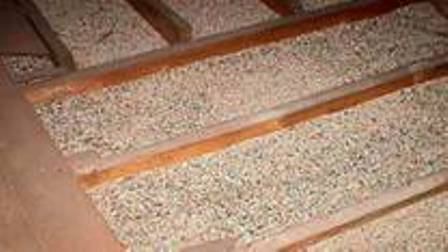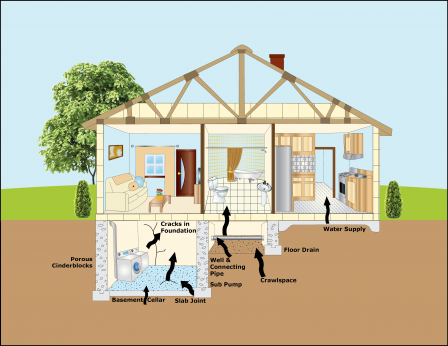Asbestos

Asbestos is a naturally occurring silicate mineral that has historically been used in building materials. Cutting, tearing or abrasion of asbestos materials can release asbestos fibers into the air. If inhaled, the asbestos particles can cause lung cancer and other forms of lung disease. Examples of materials that might contain asbestos include vermiculite insulation in attics and walls, tape used to seal old ducts, insulation on steam pipes and ducts, door gaskets in furnaces, plaster in old houses, vinyl flooring, and wall cladding. To find out more about asbestos, see the EPA’s asbestos website.
Volatile Organic Compounds
Volatile organic compounds (VOCs) include formaldehyde and a variety of other chemicals, some of which may have short- or long-term adverse health effects. VOCs can be found in insulation, cabinetry, carpets, paints, and stains. The U.S. Environmental Protection Agency’s Indoor airPLUS Program recommends choosing no- and low-VOC versions of these types of products for installation in the home. The Building America Solution Center includes guides to help contractors meet the requirements of the EPA’s Indoor airPLUS checklist. VOC-containing products such as solvents, cleansers, coatings, and fuels are often stored in the garage. Attached garages should be well sealed from living spaces and possibly ventilated with an exhaust fan. Furnace and air conditioner ducts and air handlers should not be located in garages, which could enable the spread of pollutants throughout the house as described in the guide no ducts or equipment in garages. Flammable solvents and fuels should not be stored in any part of a residential structure. To find out more about VOCs, visit the EPA’s website on indoor air quality and volatile organic compounds.
Soil Gases including Radon

Air sealing to reduce heat loss may also reduce natural air changes in the home that dilute soil gases or indoor air pollutants, leading to increased concentrations of soil gases in the home. Air sealing steps should include air sealing of any cracks in and around the subfloor to minimize soil gas entry. A vapor barrier should be installed over any bare earth floor in a home’s basement or crawlspace; the polyethylene sheeting should be taped at all seams and sealed to the walls as described in the guide Capillary Break at Crawlspace Floors - Polyethylene Lapped Up Walls and Piers or Secured in the Ground. If you are detecting oil, gasoline, or sewer gas odors inside the home, investigate to determine the cause. A plumber or remediation specialists may be needed to mitigate the issue. See Step 2 in the Existing Homes Tool on ensuring fresh air, which includes sections on providing ventilation and radon mitigation. Also see the Indoor airPLUS checklist in the Building America Solution Center. The EPA has more information on reducing radon and other soil gases at the Indoor airPLUS program website and the EPA website on radon.
For information on radon mitigation systems see the following guides: Vertical Radon Ventilation Pipe and Radon Fan.
Lead
In homes built before 1978, retrofit workers should assume that paint is lead based. Any work on window frames and other painted surfaces should follow all state and federal laws for handling hazardous materials. Follow the most current version of EPA’s Lead Renovation, Repair, and Painting Program Rules.
Safety
During any hazardous materials remediation projects, follow safe work practices to minimize impacts to workers’ and occupants’ health. See the U.S. Department of Energy’s Standard Work Specifications for more information about hazardous materials in homes.
More Info
The following authors and organizations contributed to the content in this Guide.
Pacific Northwest National Laboratory